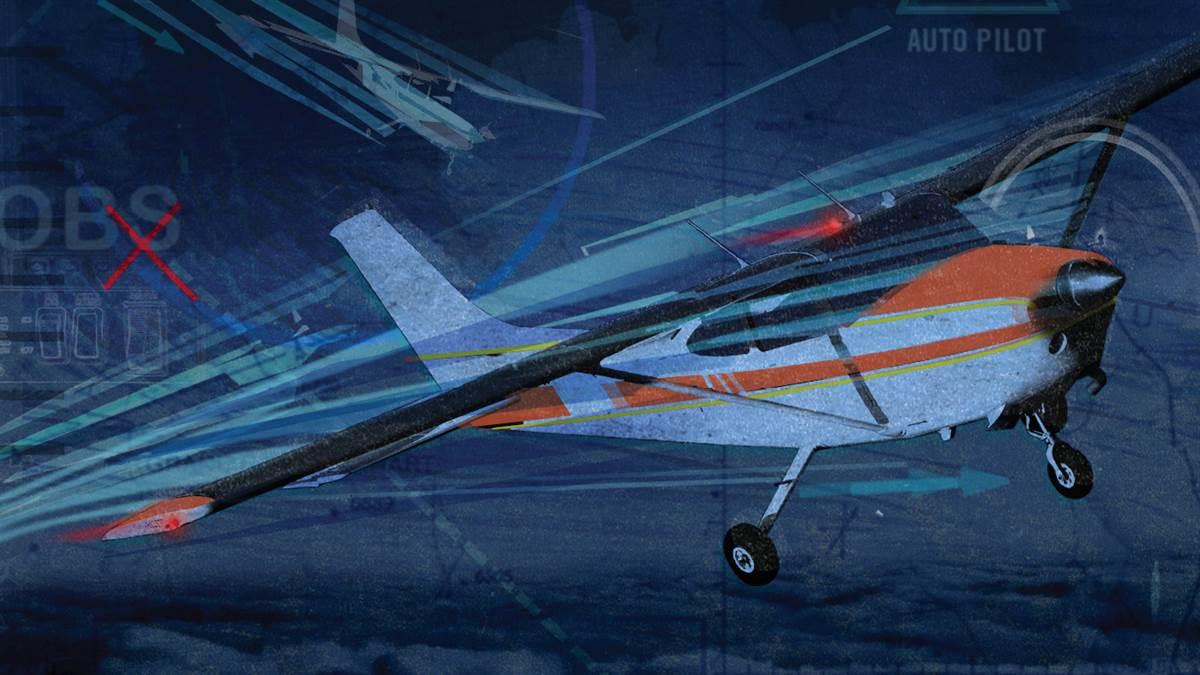Autopilot mayhem
Get-home-itis leads to a struggle in the clouds
By Joe T. May
I left Leesburg Executive Airport (JYO) for Norfolk International Airport (ORF) in bright, clear day VFR conditions, flying a rented 1999 Cessna 182 Skylane, with a two-axis autopilot.

I had not flown this specific 182 before, so I verified that there were no squawks on the aircraft. I enjoyed an uneventful flight to Norfolk, with all systems functioning normally.
The day was a full one, busy with meetings until 5 p.m. I was tired but anticipating the flight home to Leesburg. However, just after departing Norfolk VFR, I encountered Level 3 and 4 precipitation and was diverted to land at Newport News Airport (PHF) to wait for better conditions. The storms passed over Newport News by 8:30 p.m. but the ceiling was now down to 600 feet; visibility was two to three miles. Leesburg was well above minimums and there was no convective activity between the two airports. It was now a very long day, but I believed I could complete my flight home, even though it would now be single pilot, night, and instrument conditions. I filed IFR, preflighted, and departed from Runway 3, climbing into the overcast at 1,000 feet, then climbing to 3,000 feet direct Hopewell VOR.
The controller immediately asked me about my on-course heading and instructed me to climb and maintain 6,000 feet. A brief moment of confusion passed as I realized the post light on the VOR omni-bearing selector was out, and in error I had misread the To/From pointer. I had turned to the reciprocal of the correct heading. Feeling a little stressed about my mistake, I corrected the VOR OBS and adjusted the autopilot heading bug to the correct heading. Then I engaged the altitude mode of the autopilot to 6,000 feet with a climb rate of 600 feet per minute.
As soon as I engaged altitude mode on the autopilot, the nose of the aircraft pitched down sharply and continued to try to pitch down ever farther. I pulled the yoke with all my strength, and was just strong enough to override the autopilot and arrest the descent. However, I badly overcorrected and immediately began climbing very steeply nose up. I pressed the yoke-mounted autopilot disconnect switch, firmly, multiple times, but the autopilot remained connected.
I was still in IMC and my best efforts to control the aircraft were devolving into a series of nose-up and nose-down cycles coupled with substantial bank angles. In between cycles, I also tried several times to turn the autopilot off using the mode selector switch on the panel. No luck. I tried reaching for the autopilot circuit breaker; however, I believed I could not afford to take one hand off the yoke or divert my eyes from the artificial horizon.
I was getting fatigued, struggling with basic control, and was beginning to think this was going to end badly. I managed to transmit to Norfolk Approach that I had a runaway autopilot and, I wasn’t sure I was going to be able to handle it.
Approach asked if I wanted to declare an emergency, and I said, “Yes!” Approach then cleared traffic out of my way and gave me a vector to Newport News. I renewed focus on the artificial horizon and began to gain some control. However, I still couldn’t imagine how I was going to fly an instrument landing system approach with marginal attitude control and several hundred-foot excursions in altitude.
Suddenly, the autopilot disconnected and to my great relief, the controls were normal again. Looking over, I noticed the autopilot circuit breaker had popped open on its own (probably because of overloading the servo motor). After taking time to calm down, I advised Norfolk Approach I had regained control and began my descent, broke out at 1,000 feet, and gratefully landed at Newport News.
Compounding the equipment malfunction, I did multiple things wrong: Night, single pilot, and IMC in an unfamiliar airplane adds up to a large risk. “Get-home-itis” was also a factor in launching into night IMC after a long day. Fatigue reduced my ability to perform basic functions and my ability to handle the unexpected. I should have just stayed on the ground at Newport News after my first diversion and gotten some sleep. These are all common factors in many fatal accidents, and I am fortunate the sheer volume of errors did not seal my fate.
What did I do right? Fly the airplane, even if it’s all you can do. Declare the emergency; Norfolk Approach was a great help. Never give up.
I now never fly an autopilot-equipped aircraft without testing all the methods to disengage it during preflight, including testing that the forces required to override the autopilot are reasonable and according to specification.
I also updated my personal minimums. I never fly unless well rested, and I never fly in IMC unless I am familiar with and happy in that exact aircraft. Last, but not least, I don’t fly night, single pilot in IMC.
Joe T. May, of Leesburg, Virginia, is an instrument-rated pilot with 2,000 hours between fixed- and rotary-wing aircraft.


